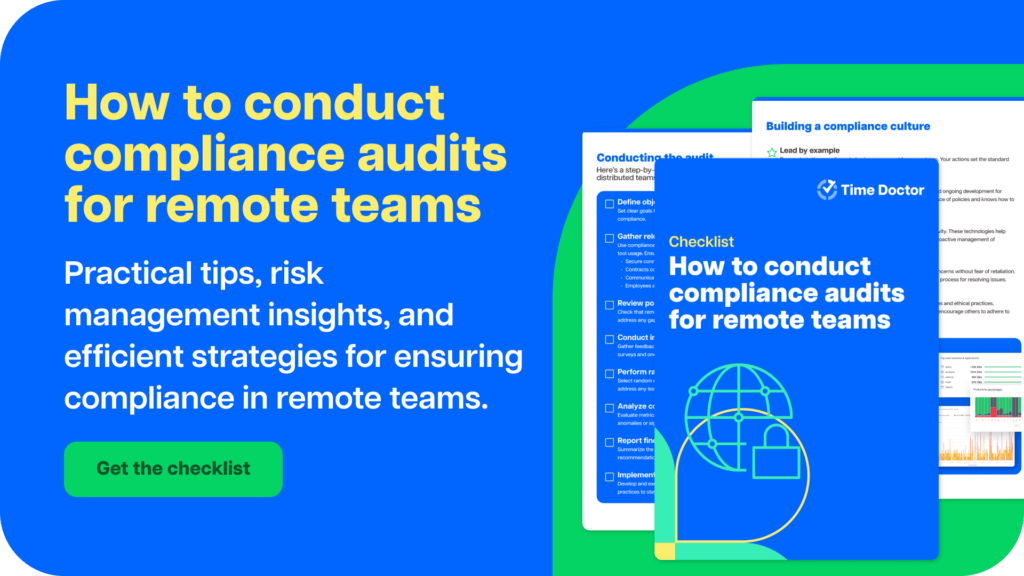Regulatory compliance in call centers helps prevent unethical business practices and promotes a better customer experience.
However, as call centers are subject to several regulations, it can be challenging to stay updated on each, resulting in call center compliance issues.
In this article, we’ll explore 10 common call center compliance issues and why staying compliant is important. We’ll also highlight four useful tips to keep your business compliant.

Table of Contents
- 10 common call center compliance issues
- Why is call center compliance important?
- 4 proven tips to keep your call center compliant
Let’s dive right in.
10 common call center compliance issues
Call center compliance is a set of regulations and standards that call centers must follow to ensure fair practice and data security. It covers a range of compliance requirements, including cybersecurity, customer protection, and best management protocols.
Sounds important, right?
So let’s take a detailed look at ten call center compliance issues that you might face:
1. Recording and monitoring calls without consent
Countries like Australia and the USA require the consent of both call center agents and customers to monitor and record calls.
Whether it’s inbound calls or outbound calls, the call center needs to disclose that the calls will be recorded and monitored and that customers can opt out if they’re uncomfortable.
This is especially important if you’re using agent performance monitoring software, as some countries have telemarketing laws that prohibit eavesdropping. So if a supervisor listens to the call without permission, it can be a compliance risk.
Additionally, to get consent from agents, every employee should sign “notice and consent” documents that verify their agreement.
Lastly, you need to audit recorded calls as soon as possible to gain valuable insights into customer interactions.
2. Violating outbound dialing restrictions
Regulatory bodies such as the TCPA (Telephone Consumer Protection Act) lay down certain directives on outbound calls to make communication with customers more agreeable.
Some of these TCPA directives include:
- Telemarketers cannot use automatic dialers to contact wireless phones.
- Customers can withdraw their consent in any reasonable way, at any time.
- Call center agents cannot call people using reassigned (a number reissued to a new customer) phone numbers without prior consent.
- AI and pre-recorded telemarketing calls are prohibited.
- Agents must exclude numbers on the Federal Do Not Call Registry (DNC).
- Customer interaction must only occur between 8 AM to 9 PM of the caller’s local time.
- Agents must tell customers who they are and why they have called.
However, you can use timezone management tools, create your own DNC list, and frequently update your call list to meet compliance regulations.
3. Calling numbers on the DNC list
Some countries like Singapore and India have a national DNC where people can add their phone numbers if they don’t want to receive telemarketing calls.
Call centers and BPO providers that violate this registry are liable to pay heavy fines up to $40,000 per violation.
To eliminate the risk of non-compliance, you can:
- Subscribe to relevant national and state DNC lists.
- Create your own denylist for customers who revoke calling consent.
- Delete DNC and delisted numbers from your calling database.
4. Recording payment information
PCI-DSS (Payment Card Industry Data Security Standard) prohibits call centers and contact centers from capturing sensitive credit card data like CVV, PINs, and magnetic stripe information.
This regulation applies to any form of communication (verbal, written, or electronic) that may take place during a call.
To ensure PCI compliance, you can:
- Provide tools with a “pause recording” functionality.
- Use an API fix that automatically pauses recording when entering credit card information.
- Offer “touch-tone” dialing and tone suppression functionalities to customers for entering credit card data.
- Enforce rules that prevent agents from noting down cardholder data on paper.
5. Sharing health data
Government bodies establish health information protection acts such as HIPAA (Healthcare Insurance Portability and Accountability Act) to prohibit the exposure of patients’ health data.
To ensure HIPAA compliance, you can increase your network security and allow only authorized access to your private communications network.
You can also use a cloud service provider that provides administrative and technical controls if your call center transmits medical information.
6. Allowing unrestricted network access
PCI compliance requires call centers to assign unique agent login IDs to access campaign and customer information.
It also helps managers and regulatory organizations trace the source of data leaks or thefts if needed.
Moreover, you can assign unique IDs with tiered permissions and security clearance based on agent roles. For example, you can enable two-step or single sign-on authentication when remote agents access sensitive data.
7. Lacking communication protocols
Call center agents should always speak calmly and use non-violent language on inbound calls and outbound calls.
However, if your call center deals with debt collection, the situation can escalate easily and become an integrity and compliance risk.
To safeguard consumers against unethical practices, some countries have regulations for call centers and BPO providers dealing with debt collections. For example, the FDCPA (The Fair Debt Collection Practices Act) mandates that debt collectors must not harass, oppress, or abuse defaulters while fulfilling their duty.
8. Network security flaws
Regulatory bodies make companies liable to protect customer and cardholder data.
This applies to call centers, too, as they manage large volumes of sensitive information.
To maintain PCI DSS compliance, you should have effective network security measures in place such as:
- Install a firewall.
- Utilize anti-malware and anti-virus software.
- Encrypt sensitive data during transmission.
- Track and monitor all access to your network.
- Test networks regularly to assess security risks.
9. Failing to protect customer data
According to HIPAA regulations and other mandates in different countries, call centers must protect specific types of customer information, like:
- Social Security numbers.
- Images of customers’ faces.
- Geographical identifiers.
- Account numbers.
To stay compliant, you can install network firewalls, anti-virus, and other security tools.
However, a more effective way would be to remove sensitive data from your call or contact center environment. You can do this through de-scoping, which involves automating payment processes or outsourcing payment services to a PCI-DSS standard service provider.
De-scoping ensures that your call center does not come in contact with or store sensitive data. It also eliminates the cost of new technology to protect customer data and maintain regulatory compliance.
10. Ignoring GDPR guidelines
Call centers interacting with European Union residents must comply with the General Data Protection Regulation (GDPR).
This involves:
- Explicitly receiving consent before recording.
- Presenting valid reasons for call recording and storing customer data.
- Ensuring that EU customers can easily retrieve their data on request at no charge.
To be GDPR compliant, you can create a call center privacy policy for customers with a GDPR addendum that describes how you comply with its regulations.
That’s a long list of things that you need to take care of to stay compliant. And while it can be difficult, call center compliance is necessary.
Let’s take a detailed look at why regulatory compliance is needed.

Why is call center compliance important?
Here are two key benefits of call center compliance:
1. Helps avoid fines and penalties
Call centers can be held liable to pay steep non-compliance fines to government organizations like the FTC (Federal Trade Commission) for any data breach.
For instance, Equifax, a consumer credit reporting agency, was ordered to pay a $700 million settlement when hackers stole credit card data.
However, it’s not simply about the monetary penalty.
Any fine or penalty can damage your business’s reputation and break your customers’ trust. It can also have a devastating impact on your revenue.
2. Builds reputation and reliability
Regulatory compliance essentials like consent and data protection are pivotal to winning customer trust and building business reputation and reliability. It prevents agents from engaging in unethical and unscripted practices that could ruin the reputation of your company.
Additionally, better calling experiences and customer service due to compliance can boost customer satisfaction and the reputation of your call center.
Clearly, compliance is important.
So, let’s look at how you can smoothly manage compliance issues.

4 proven tips to keep your call center compliant
Here are four useful tips to help you keep your call center compliant:
1. Provide routine agent training
Regular training helps your agents stay updated with relevant call center policies and practices.
These programs could cover communication guidelines as well as relevant compliance requirements issued by federal and state laws and other regulatory bodies. You can also provide hands-on sessions for new tools.
This will enable agents to deliver a smooth and secure calling experience to customers.
2. Use tools that aid call center regulatory compliance
Here are a few tools and resources that can aid regulatory compliance:
A. Time tracking
According to FSLA (Fair Labour Standards Act), call centers must record information on wages and hours worked — which makes time tracking essential.
Moreover, time tracking can help managers identify time-consuming tasks, enabling them to take the right steps to boost overall call center productivity.
But how do you track your agents’ work hours?
You can use performance management software like Time Doctor.
With this robust tool, agents can track time for all their work activities. You can monitor and review employee activity through a range of accurate reports on website and application usage.
Time Doctor also offers payroll management features to help you pay your agents without any hassle.

B. Calling automation
Using call center software that automates the storage and cataloging of call recordings will speed up the auditing process and help you easily spot compliance issues.
You can also use a predictive dialer that predicts when agents will be available and automatically sets up another call — reducing agent idle time.
However, you should avoid using automation for prerecorded calls as they are prohibited for telemarketing purposes.
Explore the most popular types of call center automation.
C. Quality assurance scorecards
QA scorecards are an essential quality monitoring resource that allows team leaders to grade an agent’s interaction with customers.
A QA scorecard built for compliance check can immediately track and flag lapses in your compliance regulations. These tools can also track compliance performance on calls and alert managers about issues.
For more information, check out this in-depth guide on call center quality assurance.
D. Customer relationship management (CRM)
CRM tools not only enhance customer experience but help telemarketers maintain call center compliance.
They are especially effective in securely recording and managing customer information. This information is also easily retrievable, as required by the GDPR.
CRMs also automate call center processes like loading account history and customer data – providing smoother calling experiences and customer service. These functions are programmed to meet regulatory compliance guidelines as well.
Moreover, they can be tailored to your data security needs.
3. Maintain a call center compliance checklist
Compliance is a continuous process that involves staying ahead of various regulations. A simple checklist can ensure you don’t forget the important steps.
Here’s what you can include:
- Ensure network security with an activated firewall, anti-malware and anti-virus software, and additional safety protocols.
- Encrypt payment and credit card information to prevent data breaches and be PCI compliant.
- Keep a log of abandoned call rates for your predictive dialer.
- Update call center software and applications to their latest version to avoid vulnerabilities.
- Generate unique IDs with specific levels of access according to your agents’ roles.
- Test network security regularly to identify weak points in your security.
- Delete DNC phone numbers from your calling database.
- Address guidelines for communication and telemarketing practices on calls.
- Verify GDPR compliance.
- Safeguard protected health information.
4. Create a call center security policy
With agents bringing their cell phones or other personal devices to work and possibly working from remote locations, call centers need to draw up a security policy informing agents of operations’ protocols and rules.
A security policy will help employees understand the consequences of compliance violations and data breaches.
Check out this guide to create an effective call center security policy.
Wrapping up
Compliance issues can not only lead to security concerns like a data breach but also impact your company’s reputation. That is why you should keep track of relevant regulations and maintain a safe environment for your customers and agents.
Go through this article to gain a deeper understanding of common compliance issues and how you can stay compliant.

Liam Martin is a serial entrepreneur, co-founder of Time Doctor, Staff.com, and the Running Remote Conference, and author of the Wall Street Journal bestseller, “Running Remote.” He advocates for remote work and helps businesses optimize their remote teams.


